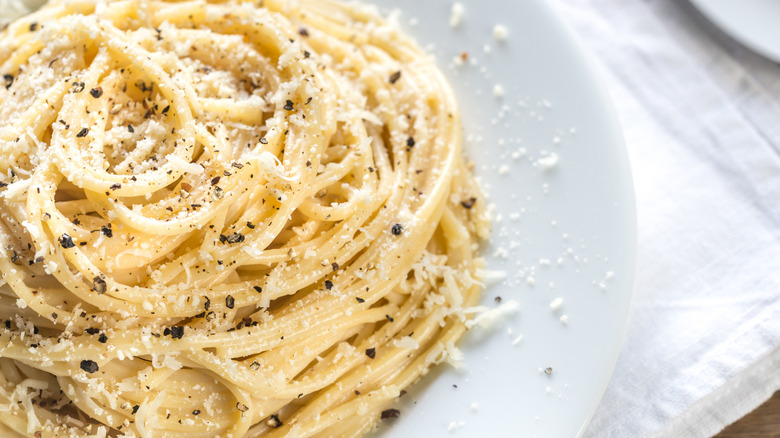Ina Garten's Creamy Scrambled Eggs Are A Twist On A Classic Italian Pasta Dish
In Ina Garten we trust, especially when she's using pasta as an inspiration for breakfast. Back in February, the Barefoot Contessa joined Jennifer Garner via Instagram to cook a popular recipe from Garten's Go-To-Dinners cookbook: cacio e pepe eggs. Cacio e pepe, literally "cheese and pepper" in Italian, is a simple pasta dish made with pecorino romano (an Italian sheep's cheese) and an ample amount of coarsely ground black pepper.
To create her cacio e pepe eggs, Garten relies on the same spartan ingredient list: kosher salt, black pepper, and freshly grated pecorino cheese, in addition to butter, eggs, and milk. However, the creaminess of her eggs, actually comes from technique rather than ingredients. After whisking together the milk and eggs and letting the butter melt completely in the pan, Garten turns the heat to low before adding the egg mixture. "If you cook it at a high temperature, it gets tough," she says. She also lets the eggs sit in the warm pan for a minute before stirring, which helps create "big clouds of scrambled eggs," as she explains.
After cooking the eggs low and slow, stirring occasionally for 15 minutes, Garten adds the cacio e pepe to her cacio e pepe eggs. "Remember pecorino is really salty so you don't want to add too much," she explains. Just like the namesake pasta dish, cacio e pepe eggs should be served immediately with an extra sprinkle of cheese, another dash of pepper, and perhaps a slice of rustic Italian bread.
How to keep the cacio e pepe trend cooking
With its salty, peppery taste, it's no surprise the cacio e pepe flavor combination is a favorite of Roman citizens and American contessas alike. But just as Ina Garten and Jennifer Garner knew cacio e pepe didn't have to stop with pasta, your flavor experimentation doesn't have to stop at eggs. Create the same taste sensation by adding pecorino and freshly cracked pepper to other breakfast favorites like biscuits, crispy potatoes, or hash browns. Pepper and pecorino can also be easily added to homemade pizza, french fries, or your favorite risotto recipe. Or give your least favorite vegetables an umami upgrade after broiling them in the oven. Everything from garlic bread to gigante beans can get in on the cacio e pepe action.
Reversing the same logic, if the classic combination of cacio e pepe has so many iterations beyond pasta, why not try carbonara or amatriciana eggs next? Perhaps the Contessa herself will give them a try in her next cookbook.

